-
pursuing a vbac with gusto
I was able to have three vbacs after an unplanned c-section with my first baby. Some of the challenges in pursuing these vbacs were the same for each pregnancy—2nd, 3rd, and 4th.
This is written out of conversations I have had with women wanting to have vaginal births after unexpected c-sections. It’s not for everyone, and the language likely won’t make much sense to you if you have not experienced what I’m describing.
This is a topic for which I feel deep empathy. I hope that my discussion of caregivers does not offend caregivers reading this. Much of what I describe was subtly implied and my focus here is on the fragility of those hoping to be brave.
Here we go.

Pursuing a vbac takes mustering together as much courage as you can and keeping that courage by your side throughout the pregnancy.
Pursuing a vbac asks you to balance the fragility you feel about your c-section and take it in hand with the hope you feel about a future birth.
It takes educating yourself about the risks which caregivers will be concerned about, and having a sense of what they are going to say before they say it.
Pursuing a vbac means making space to be disappointed when a caregiver may ask you at each appointment—“And…are you still planning to try for a vbac?”
Pursuing a vbac means digging back up the trauma you felt in your first birth, and working through it.
In my case it took acknowledging that this hope was the current deepest hope of my heart, but that it was one I was only just grasping with fragile fingers, because I also somehow believed that my ability to give birth had in fact been sliced from me.
It means going into the required meeting for your “consultation” about a “trial of labor” at a hospital knowing that you may have to disagree when/if they say, “Wouldn’t it be safer to have another c-section?”
All of this is totally worth it.
Here are some things that helped me pursue vbacs:
1. If you have mixed feelings about the care you received in your first birth, consider switching to a new hospital. I would not have undertaken this myself, but the doula I hired for my second birth sensed how hurt and resentful I was about certain elements of my care, and encouraged me to switch to a nearby community hospital.
- Reasons for leaving can be both leaving behind a place of emotional trauma, and pursuing a different type of care, it doesn’t have to be one or the other.
2. Ask for the c-section rate at your hospital. You can check it online, and it is good to ask in person as well. Ask the care providers at the hospital how they feel about their rate, and use it as a discussion tool. This is a good idea for discussion for when you go into your required consultation before the “trial of labor.”
3. Check your personal vbac success rate calculation before you discuss your plan with providers. This will give you a sense of what concerns they may have, like your weight, your previous labor experience, and your age. The facts don’t need to defeat you, but it is good to know them.
4. If you are switching hospitals, visit the previous hospital’s medical records office, and obtain the record of your birth to review with your doula or new caregiver. I went to the medical records office with my little toddler in a stroller, and we sat as the employee printed off a six inch stack of paper and handed it to me. Then I brought that to my new midwife and we talked about it together…
5. Find someone to process your c-section with. This could be a doula. This could be your new midwife. This could be a counselor, or a friend who is a really good listener. Allow yourself to mourn what hurt you about the birth, and then: let it fall away from you. After talking with my midwife, and some of the doulas that I interviewed to hire, I was shocked to find myself felt ready to let my disappointment go and move on.
6. Cleansed of some of the elements of grief and disappointment, now reflect on that birth and think about what you can change for the next time:
- For example, I decided that getting an epidural was not an option for me going into my second birth. I felt that statistically the chances of having another c-section went up dramatically if I got an epidural. So I took that option off the table beforehand, committing to myself that I would not do it. I would sometimes share this commitment and the reasoning behind it with caregivers. They would usually shrug and say something like, “Well, every birth is different.” I felt this was not only statistically misleading, but also it wasn’t helpful to me to hear it, so I did not engage with these comments.
- A decision that followed this decision was that I couldn’t be as overdue with my second baby as I was with my first (two weeks overdue, supposedly).
- So I did two things:
- First, I educated myself about my cycle and learned that I had a 31 day cycle instead of a 28 day cycle. Caregivers typically calculate your due date based on a 28 day cycle, unless you tell them otherwise. Throughout my pregnancy, I had to remind caregivers that I had a 31 day cycle to be sure they were calculating correctly. Sometimes it was correctly recorded, other times it was not.
- As I approached my due date, I asked for any natural inductions that they could offer. That meant making an appointment on my due date for sweeping my membranes.
This commitment is also what encouraged me to hire a doula, though it felt expensive (see #8).
7. While it was wonderful to have had such a happy, big 9lb 10 oz first baby, I decided it would be better for me to do what I could to have a slightly smaller baby the second time around. For my second pregnancy I tried to stop eating as soon as I was full (rather than finishing the dish just because it was in front of me) and I always ate protein first, carbs second.
- In case this is a question in your mind, I typically weigh around 100lbs and I typically gained 30lbs for my pregnancies. I gained 50lbs in my first. The birth weights for my children were as follows, the first birth was a c-section: 9lb 10 oz | 7lbs 11 oz | 8lbs 5 oz | 9lbs 1 ounce.
8. It is definitely worth considering hiring a doula. Yes, it is expensive. Yes, it could be seen as “only” self care. Even though your insurance won’t acknowledge the money saved, the fact is you could very likely go from a $50k birth to a $2k one. If you have great insurance, your doula fee may indeed be equal to what your insurance charges you for your birth. Keep in mind there are doula services offered at reduced rate for certain income levels, but you would want to research these options early in your pregnancy as they book up quickly.
But you won’t have many births in this life, and hiring an doula experienced with vbacs will very likely completely change the birth for you and your partner. Doulas like to interview their potential clients and they want you to interview them as well. So take some time to call and email people, have an interview together, and share your hopes upfront in the conversation.
That’s everything I would tell you, if we sat together and you said you wanted to try for a vbac this time. Know what you want to fight for and feel bold about sharing it, xo.
-
interact
In a video discussing the images from the James Webb telescope, Bill Nye remarks “My grandparents did not know there was relativity. It wouldn’t surprise me if in 10 or 30 years there is some discovery about dark energy and how these things interact that will change everything.”
One of the central essences of my being right now is the many selves, and the fact that all the selves are not entirely transparent with one another. As a stay-at-home mom it is paramount that I pick projects carefully, though they vie so eagerly for my attention, promising just a bit of work to complete them and the resulting feeling of accomplishment that can sometimes feel so far away when raising up little humans. Overcommitting would have huge consequences to our household—the food gathering with attempted economy, the food preparing with attempted taste, the procurement of needed clothing, the care and keeping of said clothing, the physical engagement of reassuring little bodies as they go about their growth, tracking health and wellness and adaptions to schedules and commitments as needed, noting talents and interests and finding ways to foster them that are affordable and fair to the rest of the family, the constant attempted organization:”a place for everything and everything in its place,” following up on bills, insurance, appointments, registrations, the various gifts, notes and acknowledgements needed to remain in good standing in one’s community, and if one wants to travel—the tickets, reservations, visas, itineraries…

But I need to commit to some things as my brain will fret if left to only engagement within the household, or worse, household plus a cursory engagement with national news learned via headlines and editorials. So I have these other whole self interests. My blog. Keeping up instagram documentation here and there. Reading a lot. Being involved in leadership at my church and my local library reminds me I am indeed interested in how organizations grow and change. Helping as much as I can at our homeschool weekly co-op. And then taking on projects for myself, like trying to write better, and more often. Physically tiring workouts three or four times a week, in thirty minute increments. Reading books from spiritual thinkers in attempt to keep my mind open to the work of God. Learning to garden. Trying new recipes.
When I say the selves are not entirely transparent with one another, I mean that I don’t try to explain all of my interests to anyone from one of these parties mentioned above. Sometimes I catch myself explaining something I don’t really want to explain, a fraction of the pie that I’d rather leave under the darkened tin for now, a bit of dark energy related in some way to the whole movement, but undefined for now. I don’t think all of this is unique to my spirit. I think we are intuitively woven to have many selves. I think we resist the very suggestion of being a replicable cog. Hence the exuberant human spirit of rebellion: I will not be what you expect. But, I will be much of what you love.
Seasonal psa: As of September 26, it is Poetry Unbound season. Listen in at your next podcast opportunity.
-
what it meant to consider whether Shakespeare was a woman
Three years ago the Atlantic published an article entitled “Was Shakespeare a Woman?” I read the essay while tucked into bed with two pillows and a blanket after a long day. A day when I found the bathtub strewn with hair after a child’s quick dip, the towels (all of them??) forgotten on the floor. A day when I had not said very interesting things and very interesting things were not said to me. Mostly I had repeated myself, and gazed off absently during circular story telling.
Reading the essay, I fell for the theory–well articulated and curiously substantiated–as into a hammock after a long day’s work. It only took one read for me and I was laying back, swinging within it, gently back and forth between the what and the if. Holding it in my mind as a possibility seemed to shift everything.
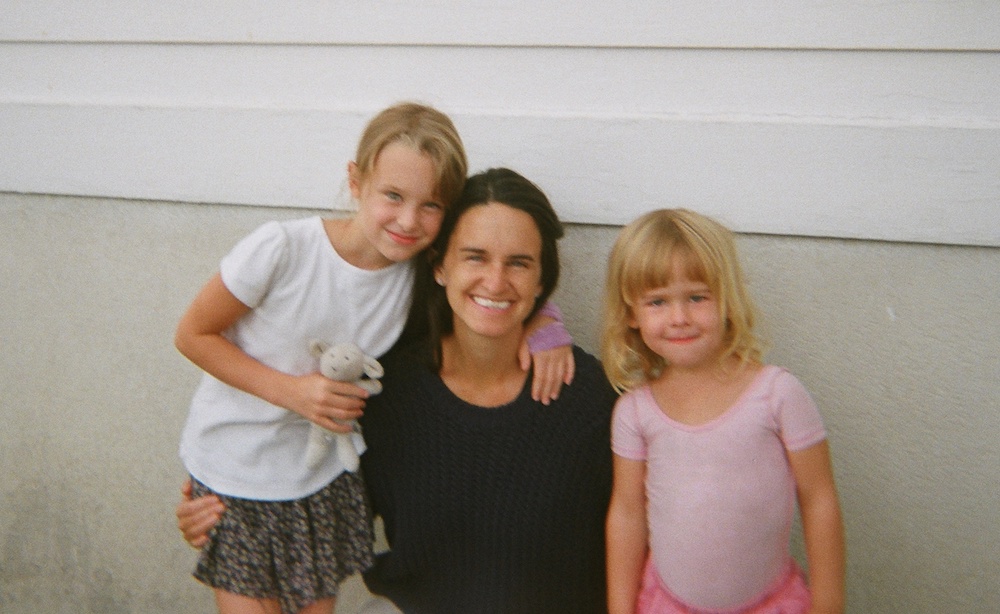
I told my daughters about the idea over breakfast the next day, and then referenced it in the weeks to come. Referenced the idea of a woman who had penned brilliant things and never received any credit for it, but watched the work be received, and maybe held their reception in her heart. Almost immediately there was a reason to reference it: while researching a paper on Laura Ingalls Wilder, Lux and I learned that there was substantial proof that her daughter Rose significantly rewrote her mother’s manuscripts to achieve the storybook-like, moral-and-simplicity focused style that is consistent throughout (arguably the very style that sells the books). In addition, Rose left journal entries that seem to show she felt unseen by the success that poured out onto her mother’s shoulders.
The points of proof that really pulled me in to the female Shakespeare theory? 1/ The fact that Shakespeare’s daughters didn’t learn to read. How could someone who invented Katherine Minola, “the shrew,” not have his female children educated? 2/ The way in which the plots seemed to understand and elevate complicated, rebellious females, even as rebellious complicated females had so little status in society. 3/ Winkler’s argument that Shakespeare left almost no documentation showing he was anything beyond an actor.
Months later, I thought to go back and look up what the reception of the article had been, outside of my personal tale of discovery. Caustic. Refuted. The Atlantic printed five subsequent rebuttals.
Okay. She probably wasn’t Shakespeare. He probably was. Did it still matter? I had floated on the boat for awhile, and seen things differently, revised a version of history I had taken for granted and took a closer look at what any of it meant to me anyhow. Felt refreshed by the whole thing. Wanted to re-read Shakespeare, actually.
Looking back, I wonder how much of my reaction to the theory flowered from the fact that I felt like an unseen Shakespeare? Perhaps mid the tawdry cycle of toasted bread slice crumbs, hair scattered across the bathtub, order, sorting, emails, missed voicemails, forgotten appointments, and trafficked errands; beyond how convincing the argument was–I was drawn to the idea of the credited one, the one history chose and raised up, as being the poseur, and the hidden one, the one who left nothing behind, being the genius.
Conspiracy theories have turned sour in the United States on the whole. Between people claiming that Sandy Hook parents weeping over their lost children were actors, to a pie slice of the population claiming the recent presidential election was fraudulent, to people declaring that airplane contrails are in fact malicious chemtrails, the mood has shifted. There was a time was when contemplating a conspiracy theory meant you had to learn more about something in order to have a theory about it in the first place.
Despite this sour turn, conspiracy theories will continue to flourish in my own heart, because they create the brilliant spark of a feeling that you know better. Some think that, but you know this. As Winkler writes in the essay, “The idea felt like a feminist fantasy about the past–but then, stories about women’s lost and obscured achievements so often have a dreamlike quality, unveiling a history different from the one we’ve learned.” I’d loved the suggestion of the mystery, the shape of a cloak within a dark doorway, the invitation to believe that maybe we don’t know absolutely everything about how history had happened.
Note: the Atlantic’s paywall is quite jumpy–you only get three free articles. Use your first click on Winkler’s essay. It is also available to read in the book 2020 Best American Essays.
Film photo finishing off a roll on a disposable camera.
-
from one cloud to another
Interior days. Gray skies, crisp cold grass, damp weather. Made a soup and didn’t like it. It’s time I admitted I can really only eat beets with a vinaigrette. I have a spiral bound book of soup recipes my grandmother loved, I should have started with those recipes, rather than a random one from online. The trouble is, I get distracted: merrily cobbling a soup together without examining the recipe closely because I’m always thinking about the bread that will come with the soup: flaky buttermilk biscuits, crispy olive oil croutons, cornbread with honey.
So, didn’t like the soup. Composted it. I’ve found that one of the great joys of composting is flinging food that didn’t work out on to it, the best regift. I do see the genius of soups though; why my grandmother loved it for lunch and had it almost every day. Often times you get in four to six vegetables in one go. And it’s so elegant…somehow.

I continue to reflect on what ten years of parenting has meant, since we passed that turn around the sun this summer, in July. Where it has brought us. How we have changed. Especially: which roles have faded somewhat, and the new ones that have emerged. I’m working on a “ten thoughts for ten years,” but concrete descriptions of the whole thing elude me. They roll away from me like yarn in this case. Having everyone in the house all the time forces the roles of each parent-child stage to be more transparent. They watch how things go with one another. My parenting of one child seems strange to the other children, as it is not age-appropriate to them. I see one needing a project, a chore, and a walk. I see another needing an hour of working together over a paper. I see one tucked away, listening to an audiobook, happy just for a snack now and then. Sometimes the girls demand that they be treated equally in all things and it’s just so awkward. It doesn’t work.
One challenge of this stage is taking on the role of severe matron. Taking it all so seriously–watching for squabbles, registering the temperature of the moods, keeping tabs on the bottomless groceries, and laundry and clutter. I find myself correcting more than laughing.
Midst-reflection (as a result of?) I’m backing up all of my photos and videos. Ten years of parenting–it is far too much for any laptop to manage blithely. I prefer laptop actions to be lithe and swift; the photos are holding us back. So I’m putting them on a hard drive, plus uploading them to the cloud (amazon, all the clouds seemed shaped as amazon these days), and seeing them sorted under a different algorithm, with ones I haven’t seen in forever popping up. I can’t believe how few photographs and videos I took of our first baby. Evidently Rachael in 2011 could go days, weeks, without bothering to take a photo. Compared to the hundreds…it’s definitely escalated. I bought my first iphone when I was pregnant in 2010; actually, I had to leave the store mid-purchase because I was about to faint and I had not figured out how to manage the pregnant metabolism, aside from wondering if the At&t guy had an orange juice in the back. I did get the phone in the end, and the photos followed. I think we’re all better photographers than we were before instagram, we don’t give ourselves enough credit. Staring at screens and thousands of photos has payed off, a bit.
Though I am now playing nursemaid to them, shepherding them gently from one maternal cloud to another, I am grateful for the photographs and especially the videos, wow. The videos of a three-year-old talking to a one-year-old. A two-year-old telling me something, only translatable by my repeating it back on video. Of dancing. Walking. Laughing. Tense facial expressions while having their face painted. Passing time in an apartment on a dingy carpet that only a few of them remember now. Some of the value comes from the “this is how it was” feeling that I want to share with the kids when we watch these together. This is how it was–we just hung out a lot, and tried to eat and sleep on time, you were a little confusing, and I was never sure what you wanted.
In the super sweet and startling memoir Everything Sad is Untrue, Daniel Nayeri declares, “The patchwork story is the shame of the refugee.” He misses all the things his mom couldn’t bring with them when they fled Iran. He misses the end of a childhood reminisce, and the middle of a story his grandfather would tell. He misses the photos and the old bedsheets. He writes so clearly of this missing-heartache into his book, you can’t help but clutch your trove of complete memories with gratitude, to say nothing of fancy photo books or bobbling framed smiles.
-
blankets / waiting on monarchs
Dear friends, a nonprofit that I follow closely was recently presented with a startling need: 1300 Syrian refugee families living in homes with no heat, no mattresses, no blankets.
A big part of my winter life in Vermont revolves around blankets. I spend every single evening tucking our two youngest girls under blankets–draping the blanket just over that invisible line across their shoulders, straightening the lines, running the tips of my fingers over the folds. We have plug-in heated blankets piled on couches, waiting for someone to snuggle under them. The girls have large bedspread blankets that they consider their favorites and often drag downstairs to setup the boundaries of a game, or their space for an afternoon. And then there is the three layer cake approach that I like to keep on our bed: a lightweight quilt, then a wool blanket layer, and then a fluffy down comforter layer on top.
This nonprofit, Partners Relief & Development, is one of those small-team, rapid-action, quick to the disaster operators. I always have the feeling that once my money is deposited with them it is immediately withdrawn to purchase a bag of food or give a reusable feminine hygiene kit to a woman anticipating her next period that very day.
By their estimate, $35 will buy enough blankets and mattresses for one family of five. And another $35 can buy a diesel heater to heat their space. The temperatures where these families are in Northern Syria is very similar to Vermont right now: 30s and 40s.

This photo was taken by my friend Ashleigh Coleman. I have an Advent meditation and series of photographs by her to share with you below. She and I want to direct energies toward getting these families supplies to keep them warm. The sooner, the warmer! To that end, Ashleigh will send a 5×5 print of this photograph^^ to anyone who donates to Partners Relief’s blankets campaign.
To receive a photograph in the mail, email a screenshot of your donation (you’ll receive an email receipt shortly after you donate) and include your mailing address to me at rachael.ringenberg(AT)gmail(DOT)com. Or, if you have a google account, upload a screenshot of your donation and share your mailing address with me right here. For the sake of matriarchal holiday sanity and to give the USPS any break we can, these prints will be mailed in January. If you don’t need a print, but would like to have your donation noted in our collective whole, you are still welcome to share your donation receipt with us.
Thank you!!?
And now, for Ashleigh’s mediation on Mississippi monarchs and Advent, accompanied by 17 images from her lockdown this spring:








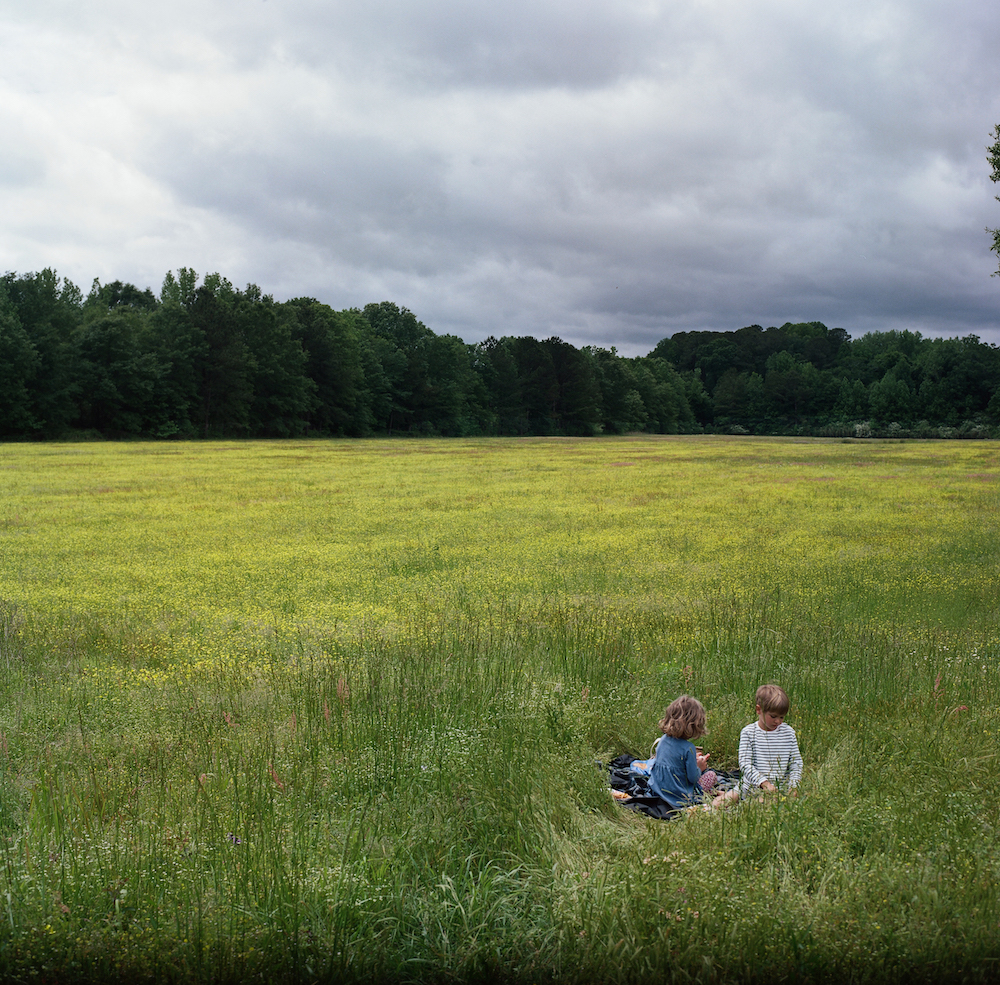








Ashleigh writes:
This is not your typical advent reflection. This is not our typical year.
Anticipation and waiting mark this season. But every day since March has been a practice in waiting for answers, in anticipating life returning to normal. So maybe this is a traditional reflection, but instead of holly and lights, I’m meditating on raising Monarchs.
During March and lockdown, we began walking almost daily. It gave us a combination of burning off anxiety for me and freeing energy for the children. It also unexpectedly became a tether to hope. These encounters with the wonders of the natural world reminded me to holdfast to what I know is true and good.
One late afternoon, the sun low on the horizon, we saw a lone monarch lilting across the top of the meadow grasses. Having visited Rachael and Joe the previous summer and seeing their monarchs, I immediately looked more closely at what was growing.
Milkweed. And 100s of tiny monarch caterpillars munching, unaware of the global disruptions. Thus began seven weeks of raising monarchs from microscopic eggs to instars to velvety fat caterpillars to shockingly colored butterflies on their way north.
It had been years since I was so obsessed. Each morning brought a new note in my journal on the changes in these miraculous insects. I prowled the fields. I watched. I waited. I squealed with delight when a chrysalis would form and then again when a monarch would emerge fourteen days later.
Now I keep the chrysalis husks hanging in my dining room— an ebenezer of anticipation. Waiting. Wonder.
Hope.
Ashleigh Coleman is a Mississippi based photographer, and mother of three. Most recently her work has been featured in A Yellow Rose Project (click that link, it’s an incredible project!) and she was recently named a 2020 Southern Arts Southern Prize & Fellowship recipient.
-
Photos of Advent
I asked Nikaela Peters and Ashleigh Coleman if they would share photos of Advent here in December. I meant it as a ropey, generous, large theme: photos that make you think of Advent. They graciously agreed, and today I have Nikaela’s to share with you. Quietly personal but effusively in-love is how I think of Nikaela’s photography. (There are a few by her husband Thom here too.) The photography she shares on her blog often feature great blessing shafts of light, but these Advent photos are different, basking instead in the darkness, semi-darkness, and glowing dim that this season is for most of us in the North.
She shared these photos and then I wrote some thoughts to go alongside them, below. Thank you Nikaela! and I hope you all enjoy.

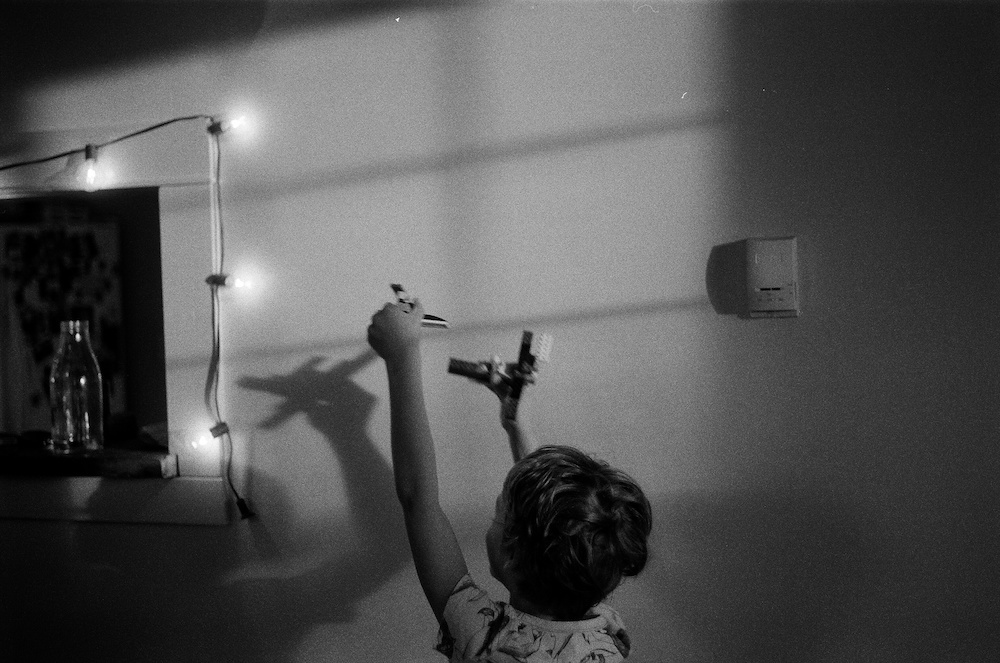

-
September
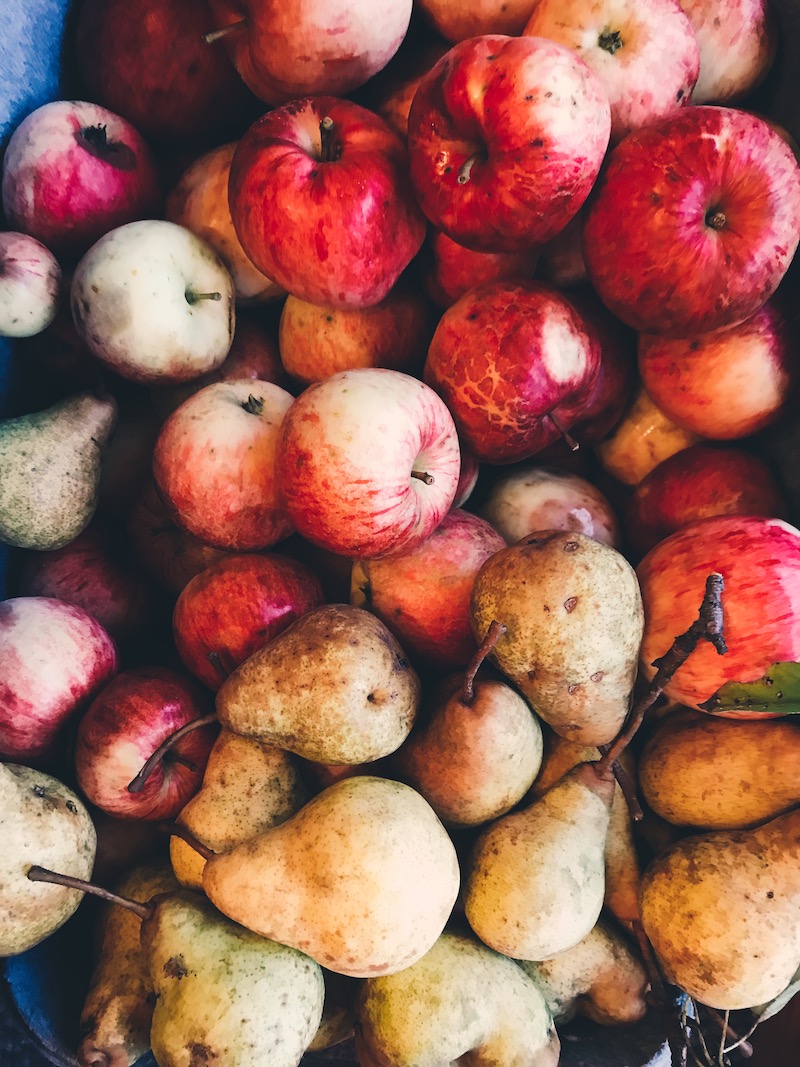

September was a cartload of treasures pulled by steady mule over the hill of suddenly bone chilling nights–the flannels did not make it onto the beds until the end of the month, replacing terribly smelly summer sheets–and creaked slowly to rest in the sunny afternoons.
The yard became strewn with crimson leaves. A sewing machine was finally settled on a desk cut to size, threaded with red thread and ready for projects. Maple soft-serve at the state fair, and the last bouquets of a flower subscription. Properly sized boots and warm tights were ordered and arrived in boxes. Woe to the generation (’tis mine) that killed off the storefront shoe shop where one could have (once upon a time!) walked in with three children and walked out with three pairs of shoes that fit. My due punishment are boxes of wrongly sized, misunderstood pairs of shoes, return to sender.
Old sweaters and cozy layers were pulled out of the closet to be washed and handed-down. I emptied drawers of one-size-too-small wardrobes, tsked the abundance of it all, and tucked these back into the very same boxes to be passed down next season.
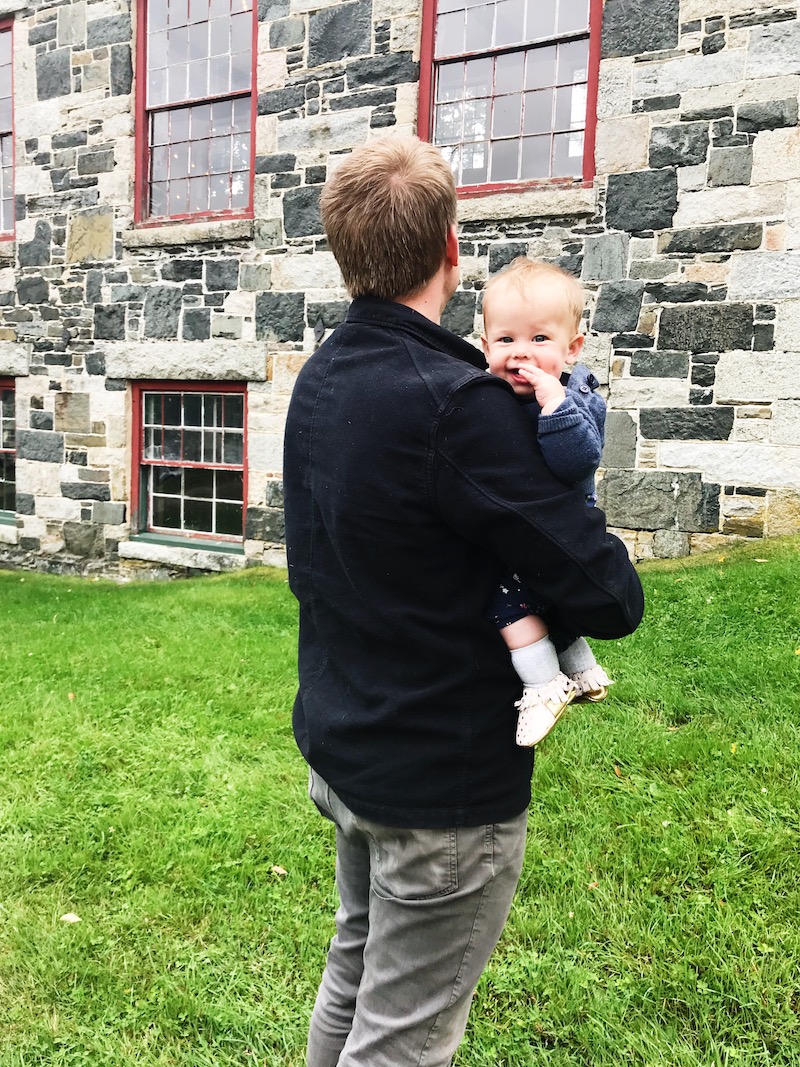
Esme turned six months old and in the blink of a midnight chime, I realized I was no longer carriage, only pumpkin, and needed to sleep train her for our sanity. She began eating mashed food of all sorts with gusto. I offered these foods to her as a perplexed dining companion, entirely caught off guard by her early interest.
 Bright and shiny sunflower maze.
Bright and shiny sunflower maze. Once more to the pond.
Once more to the pond.Homeschooling began and was scary, and then delightful, and then ordinary and soothing. I made new homeschool friends at local events and we made conversation about expectations, and savoring the little things, as is our way. I started a newsletter to write about homeschooling in more detail, so as to avoid attaching too many ribbons to my blog’s (already fitful) kite. You can sign up for that newsletter in the little box on the righthand side of this blog.
It is monthly and there has only been one issue, so you can catch up quickly.
 Out for a walk.
Out for a walk.Presidential candidate Andrew Yang has suggested the idea of a monthly universal basic income. The banality of those words universal, basic, income cause it to drift rather quickly into a divisive debate that you might find yourself arguing–does $1000 really matter? Wouldn’t all costs just become $1000 more expensive? Would we find raccoons lining up to demand their $1000 and if so, what would we say to them? And so on.
But behind Andrew’s theory is this wonderfully complex double helix idea of unobserved labor and the labor that is now, or will soon be, in the hands of robots (he mentions retail, customer service, food prep, and transportation as soon to go). One strand of the idea is the headache of society, a word that strikes fear in every political heart: unemployment. The other strand is the unobserved, unpaid labor that we rely on: merry volunteer coordinators, reliable child-rearers, cheery bake sale makers, careful wikipedia-entry custodians.
There is a delicious savor to unobserved labor, it silkens and soothes society’s function, it is the very butter to our brownie mix. It is behind every Why do you do this? -Because I want to help. We see it, of course, but how often do we not see it? And how does the person behind the unseen feel, from time to time? That is the intriguing prompt buried in Andrew’s proposal.
And it was on my mind when I considered that of the thirty dinners hath September, I made 26 of them for our family of five. I say that not as a compliant, but rather an observation of something that was not noted on my calendar and may therefore go unreflected upon. We went out to eat three times, each was a spot I’d meant to bring the family all summer: pizza by the pond, fried clams by the river, and a fancy meal on the patio behind a hotel in town.
 Hammering petals into fabric.
Hammering petals into fabric. -
striding towards eating your placenta
I confess I was not brave enough to eat my placenta but I did manage to get it home in a food-safe container and into my freezer–two big steps up from my last birth when I rolled my eyes at the midwife for suggesting I’d want to do anything with that thing. So I was delighted when my sister-in-law agreed to write about her brave entrance into the world of health-rumors and nutritional risky business. I love her medley of honest storytelling and humorous side eye at all the threads we find ourselves googling in this day and age.
Pregnancy: that time in life in which you surprise yourself again and again. The stories of strange, never-before-seen cravings and inexplicable emotions are over-told, but even still, as you watch yourself (your very normal self!) pass through each phase, it really does not fail to shock. But there are even stranger acts pregnancy invites us to than pizza rolls with peanut butter—anyone else google Evening Primrose Oil in the last trimester and stare open mouthed at the screen, reading that you can not only take it orally but also vaginally? Anyone else do it anyway?
I tend to veer on that side of things in general—I can’t resist a totally unresearched, totally natural, and allegedly miraculous supplement or an old wives’ tale that’s researched and “proven” wrong, but still sworn to be true. I’ve only been pregnant once, but the list of the things I tried during those months without (or even despite) conventional advice is pretty long:
- Megadosing vitamin c (8,000-12,000mg per day): for overall health and ~vitality~
- Blending raw frozen chicken livers into my smoothies: basically, it’s a multivitamin!
- Supplementing iodine: to make the baby smarter, of course
- Aforementioned evening primrose oil: two ways, to encourage labor
- Acupuncture during the last trimester: for “sending my energy downward”
- Collagen powder: to prevent stretch marks and perineal tearing
- Ketogenic diet: to prevent morning sickness, gestational diabetes, the afternoon slump
- Incredible amounts of very strong red raspberry leaf tea: for“toning” the cervix
- Eating raw fish, eating tons of fish: for baby’s brain
- Planned a home birth: for all the reasons people do that
Other things I reluctantly tried, but tried nonetheless: eating whole pints of ice cream with my husband just before bed, not exercising or moisturizing my skin a single time, getting out of bed in that way you’re not supposed to for the sake of preventing diastasis recti a hundred times every. single. night.
One strange pregnant-person thing that I knew I’d do from the beginning is also the one that many people tend to be most shocked by. In my second trimester, a friend of ours was over for a Bible study dinner and made a joke about how the wildest thing one might do is eat the placenta, like Brad Pitt and Angelina Jolie! There was such an expectation of communal, fellowship-building shock and horror in the joke; it filled me with such delight to say I absolutely planned to. In a different Bible study, years before, I got to know a pregnant person for the first time in my life. She glowed and glowed and then disappeared for a while, and when she reemerged she had a beautiful baby in tow. One night, less than a month before she delivered, she told us her OB had said it takes three years on average for a mother to restore the nutrients depleted during pregnancy. I’ve never found the research to back that up, but it’s always stuck with me. Sometime later, not in a Bible study, I heard about the practice of placental preservation. My first impression was that the idea of consuming the vessel by which your nutrients are transmitted and depleted seems kind of genius.
One way of categorizing the strange things I love to try is this: low risk, high reward. As of now, there are no known risks associated with consuming the placenta, when it’s properly preserved, and the list of potential benefits is impressive: Replenishing your stores of nutrients. Preventing or aiding postpartum depression. Encouraging faster healing post-birth. There are also claims about stem cell therapy, which I don’t know enough about to go into, but are extremely interesting and nothing but positive. For me, the nutrient repletion is enough. Sign me up.
People do it two ways— dehydration or freezing. There are specialists who dehydrate and encapsulate it for you, so you’re truly just taking an extra capsule every morning. The stem cell benefits are only kept intact if frozen, but for all other purposes, dehydration is absolutely fine. I once ran into my midwives’ birth assistant on the sidewalk. She was carrying a drab little lunchbox with a new mom’s placenta inside to go dehydrate. Actually, you can even dehydrate it yourself in the oven! Though then you either deal with using the powder somehow (think smoothies) or encapsulating it yourself, and that’s probably not the thing you’ll want to spend your time on in those early days.
I decided to freeze mine for the sake of simplicity: I didn’t have to hire anyone, and I didn’t have to bake anything. Homebirth made this infinitely easier for me, but as demonstrated by the lunchbox anecdote, it really can be done any which way as long as you keep it very clean. (By very clean I mean use a brand new zip-lock bag.) The most important thing is to develop a simple plan, to be fully executed by someone other than you. Talk to your healthcare provider about your plan, and designate a specific person to handle the passing of the placenta (from medical table to oven or freezer to your re-possession). Talk to your partner about your plan in case you forget to tell other people your plan. I totally forgot to do this—I had the general plan in mind but didn’t designate anyone or talk to my partner about specifics. So if I correctly recall, my muscles were still spasming from childbirth as I instructed my doula to chop and freeze it. She had never done it before, which I say to demonstrate how truly easy it is to do. My midwife stepped in to explain the process of washing it and wringing it out until it’s a “bubblegum pink color.” So she did that and then chopped it into pill-sized pieces and dropped them into an ice tray to freeze. After they froze, I put them into a zip-lock and back into the freezer. I swallowed 1-3 pieces every day, like a pill, until they were gone.
A final placental anecdote: My husband and I spent the first few years of our marriage living in Northern Ghana where he started an agricultural trading company. We had these massive windows on all sides of our living room, and I decided to start trying to grow some herbs. I had a shelf made by a local carpenter to fit the window that got the most light and gathered some seeds and soil. I spotted some pots along the roadside near our house that looked perfect and took a Ghanaian friend with me to buy them. The woman selling the pots didn’t speak much English, so I essentially mimed to communicate that I didn’t need the lids to the pots. She looked a little surprised. I told her I needed nine of them, and she looked absolutely shocked. The friend I’d brought with me often made jokes with strangers when we were out, so I didn’t think it odd that she was laughing hysterically along with an older woman standing nearby as I loaded the nine pots into the back of my car. As we drove away she just could not get herself together, and eventually she told me why: the pots I bought are made specifically for placentas. Traditionally, new fathers come to the birth site after the baby is delivered to gather the placenta into a single pot, with a lid, and bury it securely. This is rooted in the local religion, which is rooted in superstition, so really, I’m glad that all parties involved were able to laugh. The laughing only stopped when I told her about the plans for my own placenta—she was even more shocked than my Bible study friend who made the Brad Pitt joke. For whatever reason, my herbs never grew more than an inch.

Hannah’s inadvertent collection of placenta pots and cacti pictured in the opening and closing photos.
-
a no-drama guide to bullet journaling
When I realized my friend Kate was three years into her bullet journaling habit, I couldn’t resist asking her to elucidate her method and approach for us. There’s something truly remarkable about mixing the daily practical schedules of a mother, a devoted school librarian, and an ambitious household manager alongside the grander schemes of a young woman’s mind and the interests of an omnivorous pop culturist. I loved getting this peek into the inner workings and I hope you do too.
 by Kate Bowman-Johnson. Photos of Kate’s journals by Leah Hood.
by Kate Bowman-Johnson. Photos of Kate’s journals by Leah Hood. Recently, in the middle of an intense counseling session, I found myself breaking out my planner: Exhibit A.
“This is what it’s like inside my head all the time,” I told my therapist. “There’s no rhyme or reason, half of it’s indecipherable, there are pages of incomplete tasks, and there is a lot of space devoted to bad television.”
She flipped through the journal slowly. “Okay,” she said, “but I also see illustrations by your kids. There’s some beautiful art in here. I see a lot of tasks crossed off. I see smart workarounds, sermon notes, and a list of what’s making you sad. It seems like this journal helps you manage your mental health in a productive way. I don’t look at it and see someone who’s failing.”
Well. A more on-the-nose introduction to this piece I could not have dreamed up. Fellow havers of mom-brain and assorted mood disorders: welcome to Bullet Journaling as Therapy. Less a fun tutorial, more a reflection on how a book and pencil saved my sanity – and just might save yours.

I started bullet journaling three years ago during a particularly busy season in my life. I had two young kids, I was a year into an exciting but whirlwind job, and I was actively fighting depression and anxiety. I kept forgetting important dates and dropping the ball. Post-it notes were stuck to every surface. I had three different Google Calendars, none of them synced. Sometimes I would write things in a Moleskine, then lose the Moleskine. It was bad.
I don’t remember exactly how, but I stumbled on a video about bullet journaling from the method’s creator. It immediately hooked me because of its simplicity, adaptability, and clear organization. I liked the balance between freedom and structure, two poles between which I’m constantly pulled. It seemed just the thing for someone like me, who’s equal parts fastidious and forgetful, creative and downright lazy.
So I grabbed a small notebook I already had on hand, watched some more videos, read some more tutorials, and set up my first bullet journal with only a Ticonderoga pencil in hand. (As an educator, I’m here to tell you that no other pencils need apply. Some things are worth the brand name.)
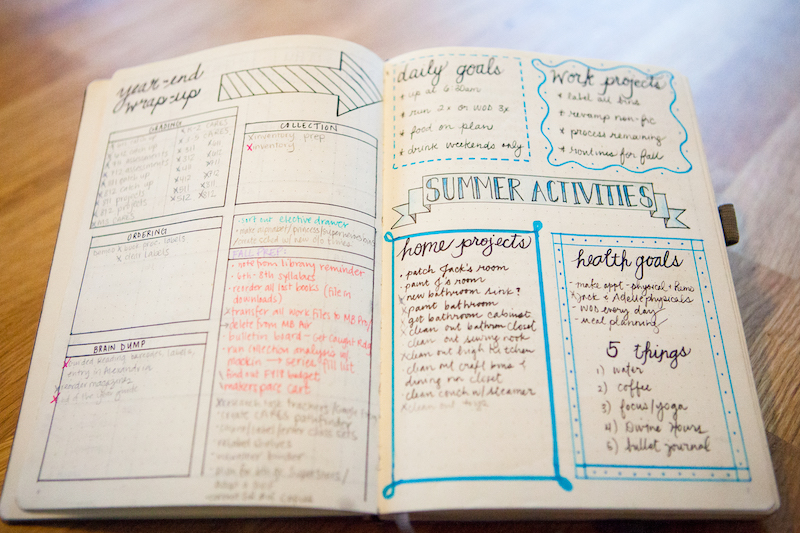
Three years in, bullet journaling is one of the few things in the universe that has not only lived up to the hype, but proved sustainable for me. It’s transformed my busy life and busy brain. It’s a way to self-soothe when I feel like things are falling apart around me; if I can capture them in the moment on paper, they’re not so daunting. They’re contained, yet accessible at all times. Mischief managed.
Since I began in 2016, much has been published about bullet journals and their Pinterest-ready cousins, dot journals. There are endless articles about how to set up your journal and embellish your journal and invest your fortune in stencils and washi tape. Such tutorials have been very useful to me (this one by Rachel Wilkerson Miller is the gold standard, if you want to familiarize yourself with the basic tenets, and I also like her book Dot Journaling: A Practical Guide), but the market is saturated. Instead, I hope to share a few guiding principles for people who are looking for more than just, as Rachael so aptly put it, a “relentless to-do list” – but may feel overwhelmed by getting started.
Flexibility is a feature, not a bug. Since you create a bullet journal by hand in a blank book, one page at a time, you can do literally whatever you want. Which is terrifying for someone like me. There is nothing I like more than following rules (Enneagram 6!), so I’ve had to push myself to bend and break them – but mercifully, journaling is built for that. For example, I used a weekly spread for months before I realized it was stressing me out and got rid of it. The world did not end; my process just got more efficient. Similarly, you’re not “supposed” to set up dailies ahead of time – but making a new spread once a week isn’t realistic for me. I make them all at the beginning of each month and I don’t feel bad about it, because it works. Meanwhile, all of my sections are interspersed with the weird art my kids make while waiting at the doctor, random lists, recipes, project-planning spreads, etc. There’s no BuJo police and they are not coming for you. Do you.
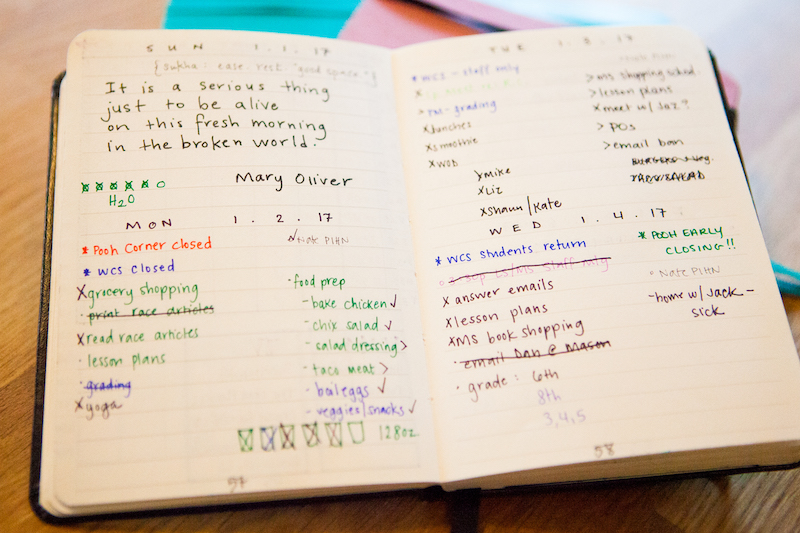
Keep the ‘gram at arm’s length. The internet is full of talented folks with gorgeous BuJo spreads and a lot of time on their hands. Their work is informative and inspiring, but take it with a grain of salt. Your bullet journal does not need reams of watercolor landscapes or brush lettering to work for you. Minimalist journaling is its own subculture, worth investigating if you get turned off by the fancy stuff. Personally, I check in on a few noted journalers once in a while if I’m feeling stagnant or need specific layout ideas. But by and large, I try to view those accounts as pure eye candy – not an indictment of how much I suck at planning and/or art. My own journals run the gamut from painstaking brush-lettering to hastily dashed grocery lists; it all depends on how much time and energy I have on hand.
Let accessories take a backseat. I know it’s tempting, because there’s so much cute stuff out there, and it’s so cheap on Amazon. As someone guilty of buying up hobby gear only to abandon it two weeks in, I forced myself to try bullet journaling for a whole month with only the resources I had on hand (journal, pencil). Then, once I had a better idea of how I was using it, I invested in a few simple tools: a small metal ruler, reusable page markers, and erasable pens. Years later, I’m the proud owner of some Tombow brush pens and layout stencils, but I usually default to a simple approach because it keeps the focus on the content.
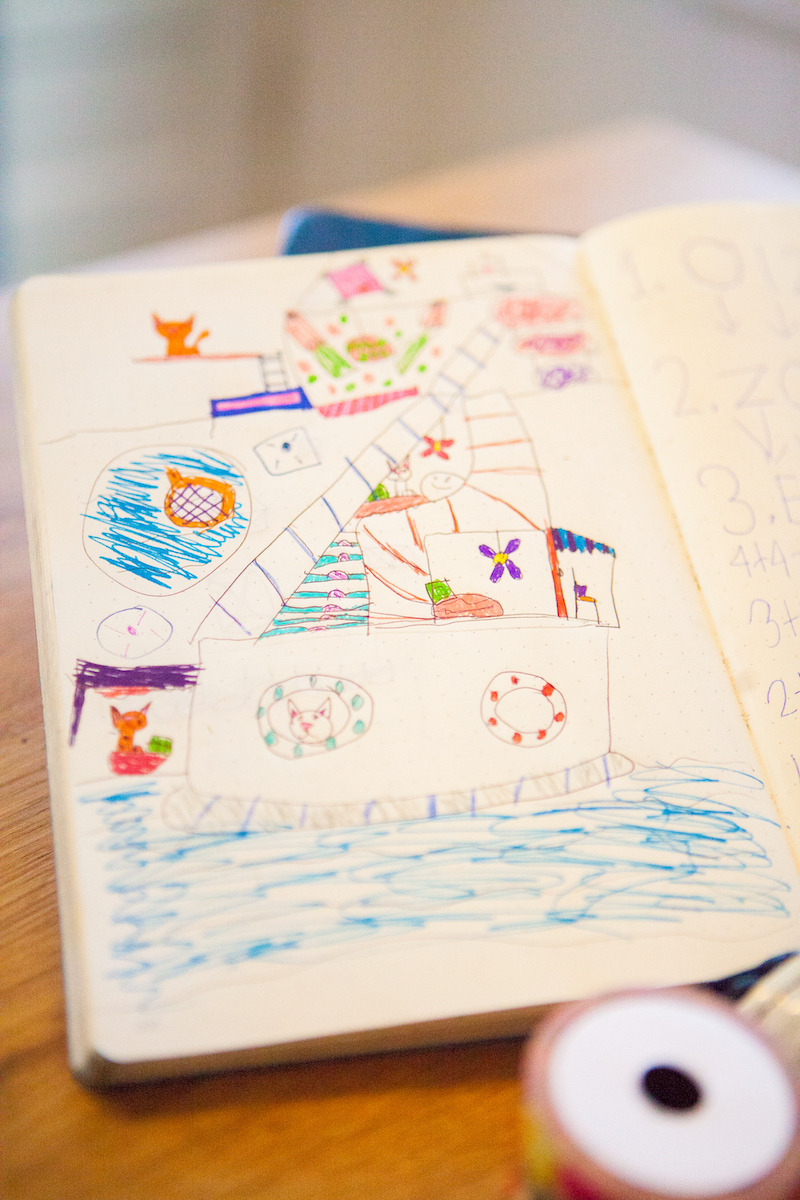
Find a balance with digital tools. When I upgraded my phone, it had an unexpected effect on my journal. I found myself abandoning the habit trackers that make dot journals so pretty, but they had become superfluous now that I had apps. Clue hacks my cycle; YNAB tracks expenses; Noom covers nutrition and exercise – so those stay in the cloud. On the flip side, I still put TV shows I’m watching in my journal (I’ll explain why in a minute), and I also meal plan on paper. The only things I duplicate are calendar appointments – hand writing them sears them into my memory, but I also need those automated pings and dings from my phone – and my reading list, which I keep on in my journal as well as plug into GoodReads. Otherwise, the division of labor is pretty clear. Don’t make your journal work harder than it needs to just for the sake of looking impressive!
Write it all down. One of my favorite BuJo functions is that of a lazy diary. When we’re on vacation, I summarize each day’s highlights, as well as recording impressions from daily life as I feel the urge. Samuel Pepys I am not, but I do like having a record of what I was thinking or feeling at a particular moment. When my kids ask about an event (“when did I find that dead mouse in the bathroom?” was a fun one), I’m just as likely to flip through old bullet journals as I am to scroll through my Instagram feed to track it down. This is also why I write what I’m reading and watching and listening to – they’re snapshots not just of the media I consume, but landmarks in time. Nothing is too big or too small to diarize alongside your to-do list, because it all creates opportunities for reflection later on.
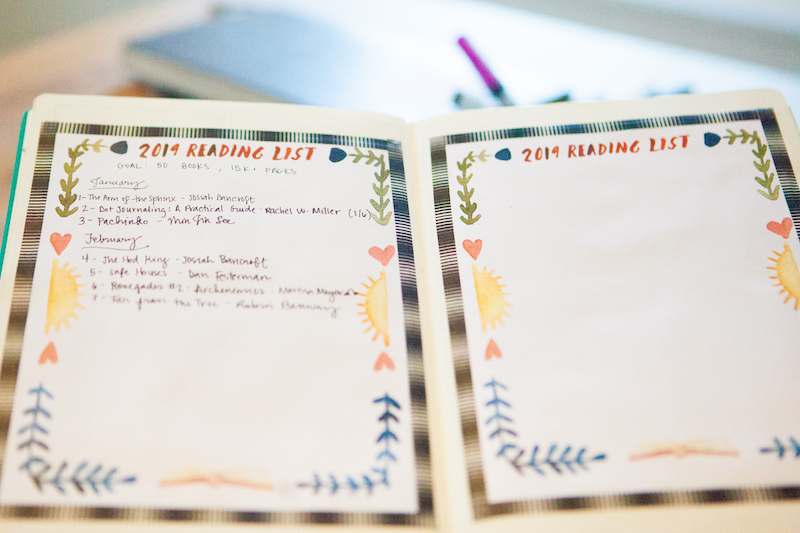
It’s okay to be aspirational. Listen. I’m sitting here telling you to be cool and not overdo it with your bullet journal, when I know full well this book sitting right next to me is slathered in washi tape and spreads designed by a professional artist and all kinds of pretentious shit. The old journals piled under it are filled with trackers I made with high hopes of developing life-changing habits… then abandoned. It’s all part of the process. A few years back, I hosted a lengthy bullet journal discussion thread on my Facebook page, in which several friends noted with envy my list of daily and weekly chores. I assured them that said chores were ambitions, not realities. I record lists like this so that I don’t waste time dithering around, wondering what to do and where to start, but so that I have something concrete to tackle when the opportunity arises. Indeed, a bullet journal can be as spare and minimal as you want – but if filling it with designs or itemizing your dreams in a spread brings you joy, go for it.
The takeaway here is that a bullet journal is not a magic, er, bullet. It will not effortlessly transform you into a totally organized, together person. Like most things, you get out of it what you put into it. If you’re looking for structure with a dash of free will, if you need a home for your fascinations and foibles and lists titled “Where Did I Hide That Thing From Myself,” bullet journaling is a good place to start. If nothing else, you can use it for show and tell at therapy.
-
List Therapy
Though we’ve never met in person, I consider Amelia a close internet friend, a longtime reader, and a woman of enormous wisdom and warmth that she can’t keep from effusing through her digital self. If I could convince her to write a weekly column for us, I would! But meanwhile, her presence on Instagram is a generous window into her humble, gracious approach to life and motherhood. In her essay shared with us here, I love the way the idealism of to-do meets elevation of memory.
It all begins with the right atmosphere. There should be a decent amount of time to think and write. A favorite pen is lovely, good posture allows for penmanship you can be proud of, and no children on your lap/on top of the table/trying to chew on your pen is ideal.
This doesn’t happen to me very often.
At this point in my life, I make lists in my head, in the quiet busyness of making beds and putting dishes away and in the pick-up line at school. I forget them all by bedtime. Still, somehow, even just thinking the lists, one by one, helps me. Like taking the messy pile of thoughts in my brain and clacking them on a desk till they form a tidy stack. I feel better, even if they eventually flutter out of my brain like leaves down the street.
When I do have time to write them down, I like to keep my lists in notebooks. By now I have enough of them to line a shelf in my living room. Though I’ve never been good at keeping a diary or organizing photo albums, I can crank out enough lists to fill a notebook in a matter of months, and flipping through those old notebooks provides the same kind of nostalgia as any diary could. Who needs journals full of thoughts and confessions when you can recall exactly how life was just by looking at a grocery list you made as a newlywed? One of my favorite notebooks holds all the lists I made as I transitioned to motherhood. One page has a list of last minute nursery tweaks, and the very next contains nothing but a column of feeding times, along with which side my newborn son fed from last. The handwriting is scrawled and crooked. The page itself is literally coffee stained. It is the most accurate time capsule.
I’ve been using list-making as a way to calm myself and sort my thoughts for years. I take it very seriously. Some lists are a comforting constant, and remain the same through the years: January lists are full of health goals and house projects and so much hope. Spring lists are all about garden plans and cleaning sprees. Summer lists are few and far between, and then August lists come with a vengeance and great detail. Parenting goals! Meal plans! School supplies! Vows to reinstate order after the wild days of summer. Then the cold, dark months come and the pages holding Christmas lists and Advent activities are decorated with stars, doodled to look as bright and twinkly as possible.
Some lists are new. For example, after six straight years of being pregnant and/or nursing a baby, I am suddenly not. So, in the spirit of my newfound freedom, I dared to make a short list of restaurants to try. Date night ideas! New territory.
Some lists are ever changing and growing. I have a To Read list, a Songs for a Good Cry list, a Things I Want My Husband to Build for Our House list. The Jobs I’d Maybe Like to Have One Day list feels exciting and scary, and my heart flutters when I add to it. I don’t know if I’ll ever create illustrations for children’s books or be a Home Economics teacher, but they’re on the list and I feel like that counts for something.
It’s easy to look through my notebooks and find the times in my life where I struggled. Almost two years ago my husband and I sold our house, moved to a small apartment with our children, and welcomed a new baby a few weeks later. The year that followed was the hardest of my life. My baby cried for months, I lived in an uninspiring place that did not feel like home, and I worried constantly that I wasn’t giving my children what they needed. I longed for a home, for some peace, for some sleep. I had no time for any sort of creative outlet, and all my emotions poured out into my lists. Oh, the detail of those lists! The order! The desperation. My handwriting was sharp and upright and eager, like if I wrote down what I wanted with enough gusto, maybe it would come. Those lists are hard to look back on.
There have been other moments of struggle where my lists lose order of every kind, and instead become long, flowing paragraphs of prayer. Prayers for myself and for loved ones. Prayers for health. Prayers for clarity and faith when I feel like I’ve lost my way. I love to look back on those lists, because they’re tangible evidence of prayers answered. Problems solved. Clearly, lists are a way I try to keep control of my life. But when I re-read these lists of pleading prayer, I’m assured I’m not really in control of any of it. Thankfully.
Over the weekend my daughter became very sick with a high fever. I accomplished nothing but the basics, fretting over temperature readings and trying to keep my hot baby comfortable. I did, however, manage to make one tiny list. It was actually more of a chart— two doses of amoxicillin for 10 days, Tylenol and ibuprofen, rotated, and the times administered. That small act of writing a list gave me a little bit of control when things felt out of my control. Some order when I was worried. A stacking of mental papers. She would be better, I knew. I wasn’t really in control of it anyway, thankfully.
But, of course, the list helped.
 by
by 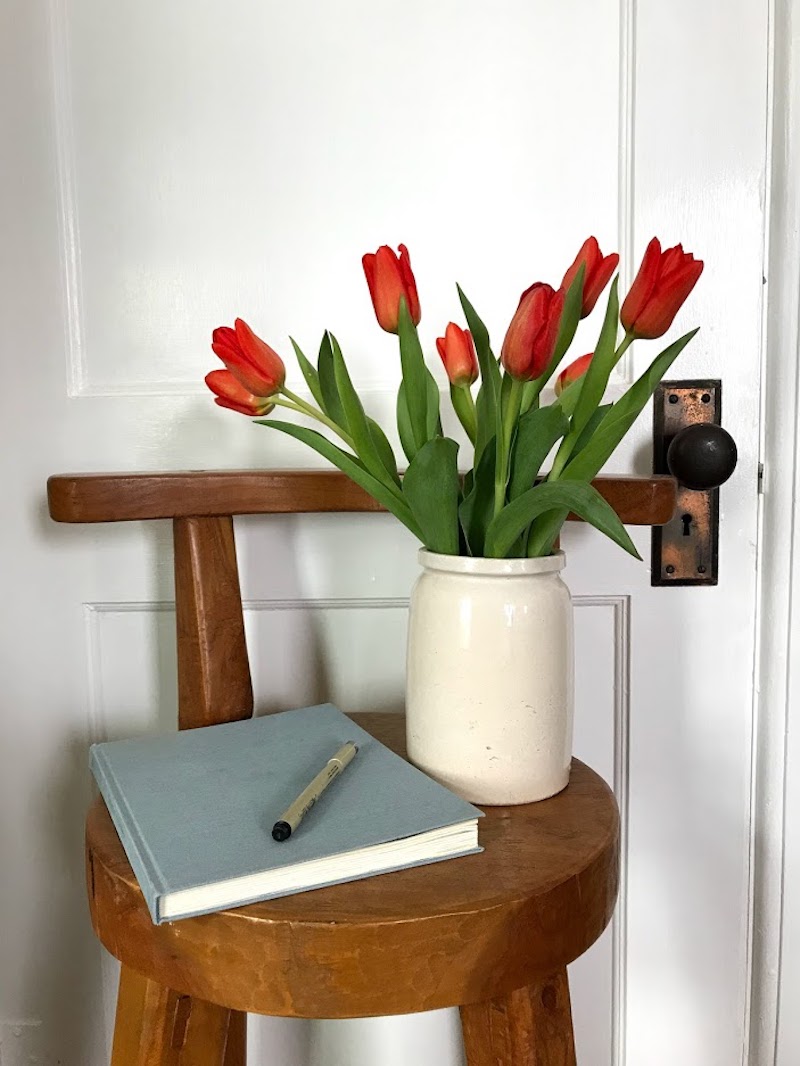 by
by